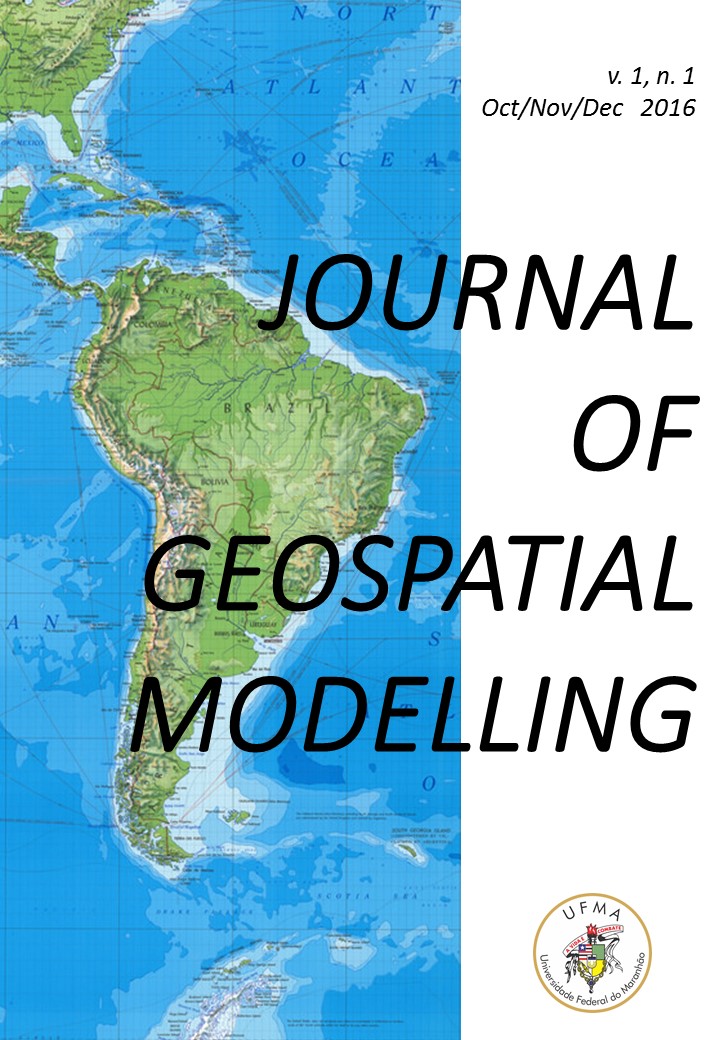BIOGEOGRAPHY OF THE CENTRAL MESOREGION OF MARANHÃO (BRAZIL)
DOI:
https://doi.org/10.22615/jgm-1.1-5812Keywords:
Biogeography, Middle Mearim, Microregions of Maranhão StateAbstract
Abstract
The central mesoregion of Maranhão is composed of 42 cities located in the middle valley of the Mearim River and divided into three microregions. The region has a high density, however, concentrated in a rural zone where the practice of the subsistence agriculture is great. There are two types of climate considered: a sub-humid climate of
C2 type and dry sub-humid climate of C1 type. This work aimed to characterize the central region of Maranhão in
demographic, economic and natural resources aspects. Geologically, are found seven types of soils in the region,
occurring with greater relevance the Yellow Latosols that even with high acidity, are handled and stand out for hosting
large monocultures areas. Is worth highlighting the high Mearim, Grajaú, and Pindaré cities microregion, by the practice of rice cultivation in the lower and fertile areas and farming practices in the Cerrado domain. Livestock in this region is characterized extensively with the cattle (mixed race and Dutch zebu), specifically for slaughter and milk production. Currently, the region is suffering by the removal of natural vegetation and mainly the removal of babassu palm (Orbignya phalerata) for housing the agropastoral system that directly harmed the extraction of babassu almond and its derivatives generating great conflicts. The industry is concentrated in some cities, focusing on food production, woodworking and metallurgic. The main biome is Cerrado, which is being removed for several purposes, however, some natural areas are taken as reservation, highlighting the Conservation Unit Private Reserve of National Patrimony (PRNP), in Bacabal city that seeks the protection of remaining forests of cocais.
Keywords: Biogeography. Middle Mearim. Microregions of Maranhão State.
BIOGEOGRAFIA DA MESORREGIÃO CENTRO MARANHENSE (BRASIL)
Resumo
A Mesorregião Centro Maranhense é formada por 42 municípios localizada no médio vale do rio Mearim e
dividida em três microrregiões. A densidade da região é alta, porém concentrada na zona rural, onde a pratica da
agricultura de subsistência é grande. Há dois tipos de clima considerado: clima subúmido do tipo C2 e clima subúmido
seco do tipo C1. Objetivou nesse trabalho caracterizar a região centro maranhense em aspectos demográficos,
econômicos e recursos naturais. Geologicamente, são encontrados sete tipos de solos na região, ocorrendo com maior relevância os Latossolos amarelo que mesmo com acidez elevada, são manejados e destacam-se por abrigar grande áreas de monocultivos. Merece destaque a microrregião do Alto Mearim, Grajaú e município de Pindaré pela prática do cultivo de arroz nas áreas mais baixa e férteis e práticas agropecuárias no domínio de Cerrado. A pecuária nessa região caracteriza de forma extensiva com a criação de bovinos (raça mestiça e holandesa zebu), especificamente para corte e produção de leite. Atualmente a região vem sofrendo pela retirada da vegetação natural e principalmente retirada da palmeira de babaçu (Orbignya phalerata) para abrigar o sistema agropastoril que prejudicou diretamente a extração da amêndoa do babaçu e seus derivados gerando grandes conflitos. A indústria é concentrada em alguns municípios, com enfoque na produção alimentícia, madeireira e metalúrgica. O bioma principal é o Cerrado que vem sendo retirado para diversos fins, no entanto algumas áreas naturais são tidas como reserva, destacando a Unidade de Conservação Reserva
Particular do Patrimônio Nacional (RPPN) no município de Bacabal que visa a proteção de remanescente de matas de
cocais.
Palavras-chave: Biogeografia. Médio Mearim. Microrregiões maranhenses.
Downloads
Downloads
Published
How to Cite
Issue
Section
License
Copyright (c) 2016 Journal of Geospatial Modelling

This work is licensed under a Creative Commons Attribution 4.0 International License.


